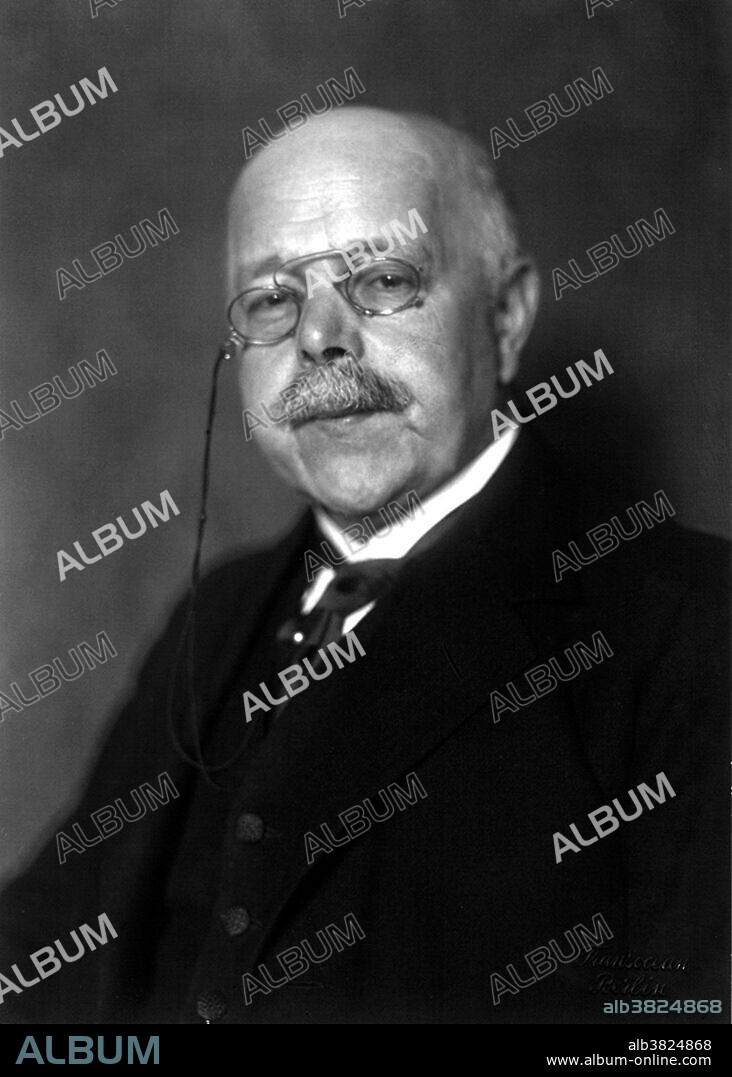alb3824868
Walther Nernst, German Chemist

|
Add to another lightbox |
|
Add to another lightbox |



Buy this image.
Select the use:

Title:
Walther Nernst, German Chemist
Caption:
Walther Hermann Nernst (June 25, 1864 - November 18, 1941) was a German physical chemist and physicist. He founded the Institute of Physical Chemistry and Electrochemistry at Gottingen. In 1897 he invented an electric lamp using an incandescent ceramic rod. His invention, known as the Nernst lamp, was the successor to the carbon lamp and the precursor to the incandescent lamp. He researched osmotic pressure and electrochemistry. In 1905, he established the Third law of thermodynamics (which describes the behavior of matter as temperatures approach absolute zero). In 1918, after studying photochemistry, he proposed the atomic chain reaction theory (when a reaction in which free atoms are formed and can decompose molecules into more free atoms which results in a chain reaction). His theory is closely related to the natural process of Nuclear Fission. In 1920, he received the Nobel Prize in chemistry in recognition of his work in thermochemistry. He went on to work in electro-acoustics and astrophysics. He helped establish the modern field of physical chemistry and contributed to electrochemistry, thermodynamics, solid state chemistry and photochemistry. He was a vocal critic of Adolf Hitler and Nazism, and three daughters married Jewish men. In 1933, the rise of Nazism led to the end of his career as a scientist. He died in 1941 at the age of 77.
Category:
black & white • Science: Personalities
Credit:
Album / Science Source / Smithsonian Institution Libraries
Releases:
Image size:
3150 x 4405 px | 39.7 MB
Print size:
26.7 x 37.3 cm | 10.5 x 14.7 in (300 dpi)
Keywords:
19TH CENTURY • 20 20TH XX XXTH TWENTIETH CENTURY • 20 XX TWENTIETH CENTURY • 20TH CENTURY • 20TH • BLACK & WHITE • BW • CELEBRITIES • CELEBRITY • CHEMIST • CHEMISTRY • ELECTRIC LAMP • EUROPEA • EUROPEAN • EUROPEANS • FAMOUS PEOPLE • FAMOUS • FIGURE • GERMAN • GERMANS • HISTORIC • HISTORICAL • HISTORY • IMPORTANT • INVENTOR (MALE) • INVENTOR • MALE • MAN • MEN • NERNST LAMP • NERNST • NOBEL LAUREATE • NOBEL PRIZE LAUREATE • NOBEL PRIZE RECIPIENT • NOBEL PRIZE WINNER • NOBEL PRIZE • NOBEL RECIPIENT • NOBEL WINNER • NOBEL • NOBELIST • NOTABLE • PEOPLE • PERSON • PERSONALITIES • PERSONALITY • PHOTO • PHOTOGRAPH • PHYSICAL CHEMIST • PHYSICAL CHEMISTRY • PHYSICIST • PHYSICS • PORTAIT • PORTRAIT • POTRAIT • SCIENCE • SCIENCE: PERSONALITIES • THERMOCHEMIST • THERMOCHEMISTRY • THIRD LAW OF THERMODYNAMICS • TWENTIETH CENTURY • WALTER HERMANN NERNST • WALTER NERNST • WALTHER HERMANN NERNST • WALTHER NERNST • WELL-KNOWN
 Pinterest
Pinterest Twitter
Twitter Facebook
Facebook Copy link
Copy link Email
Email
